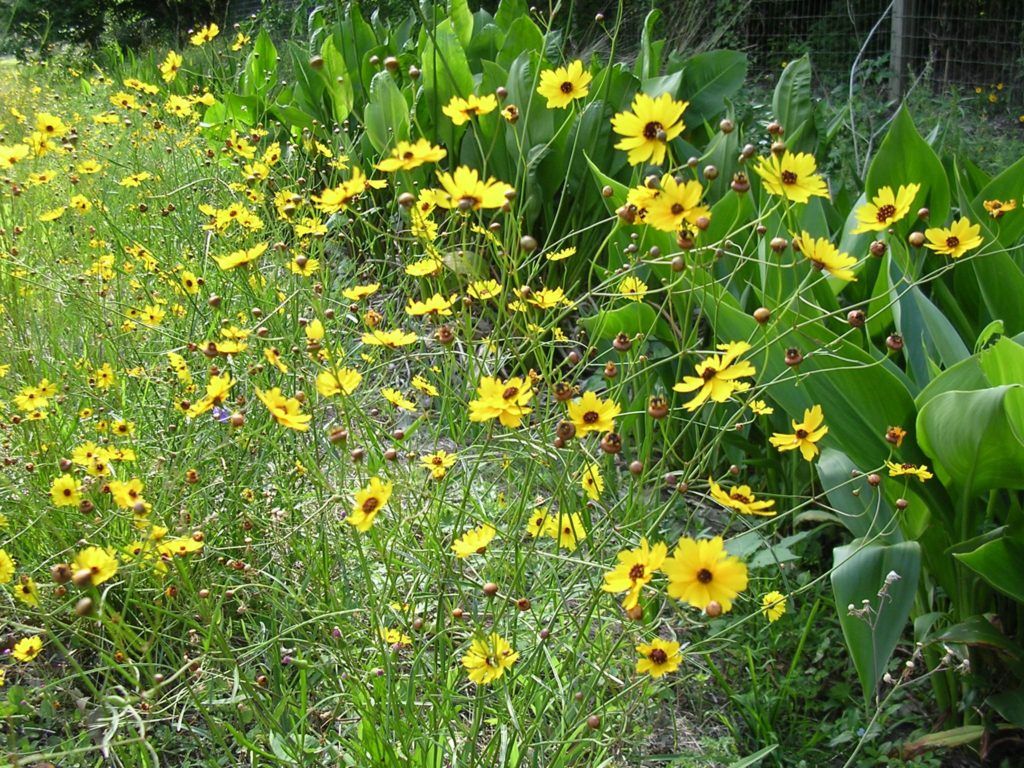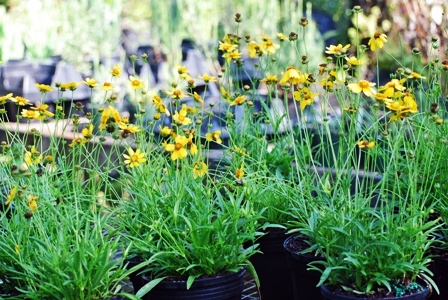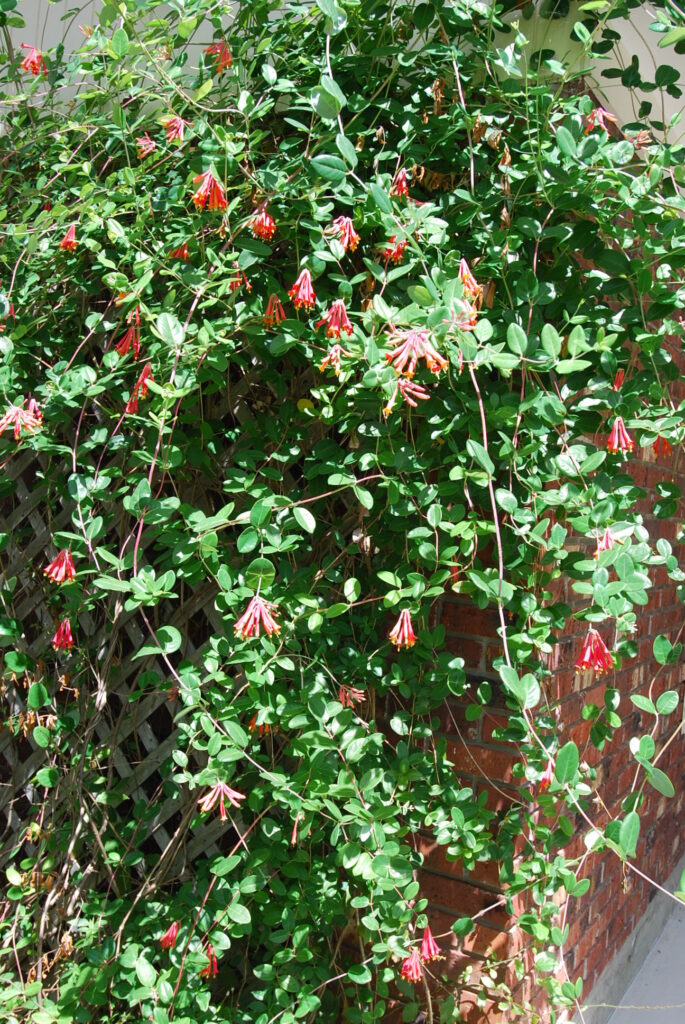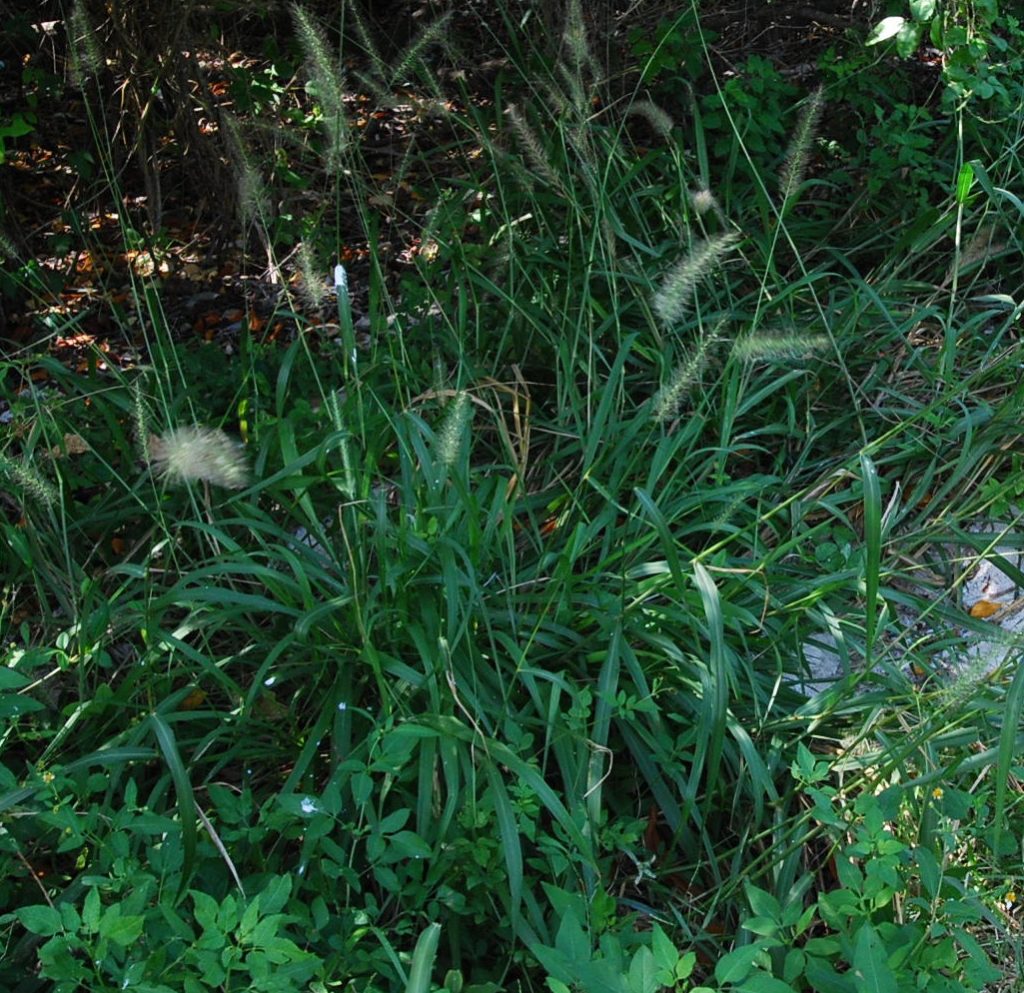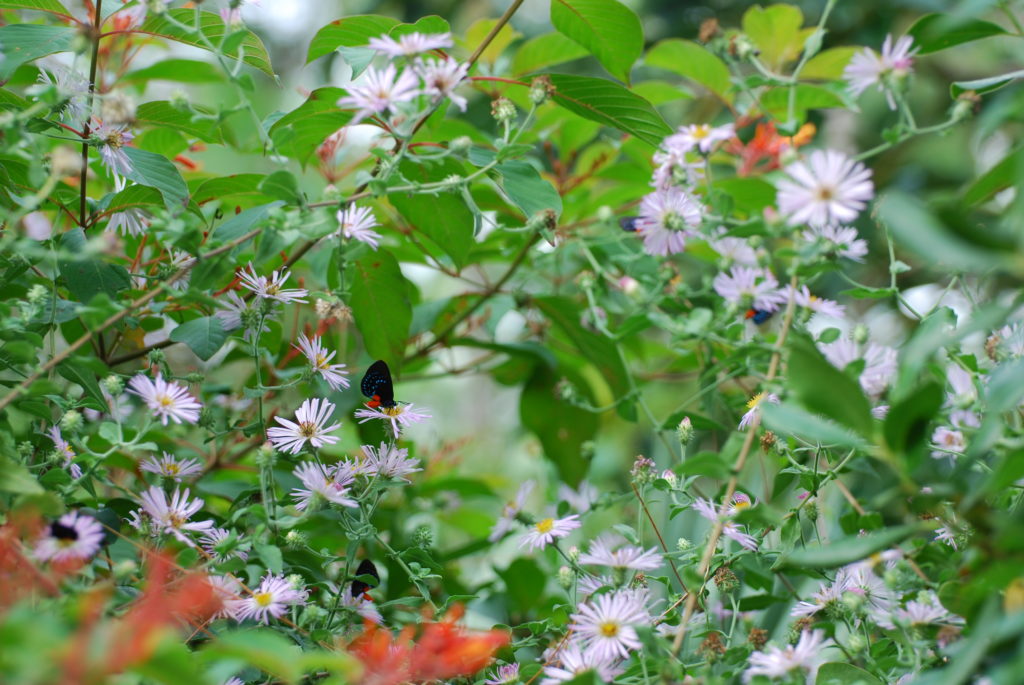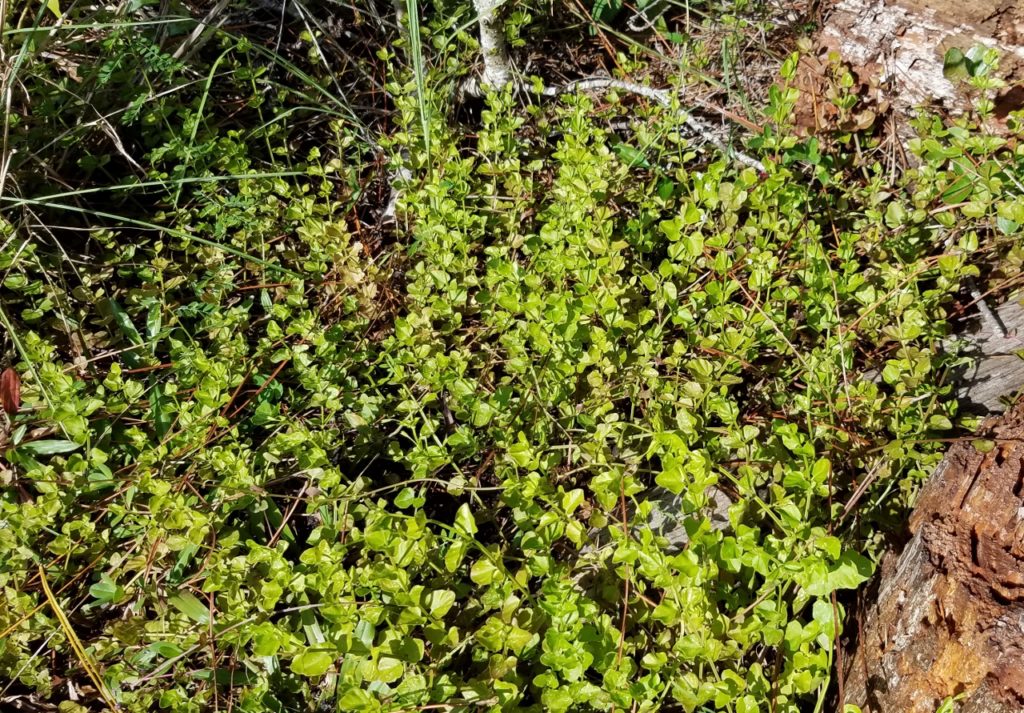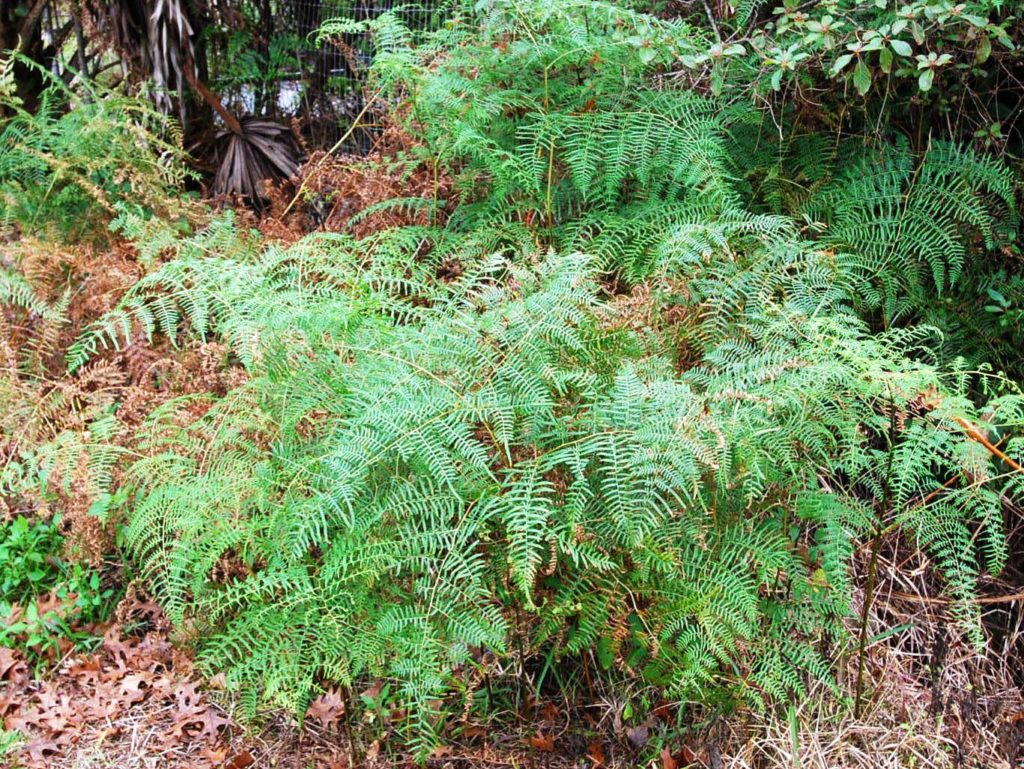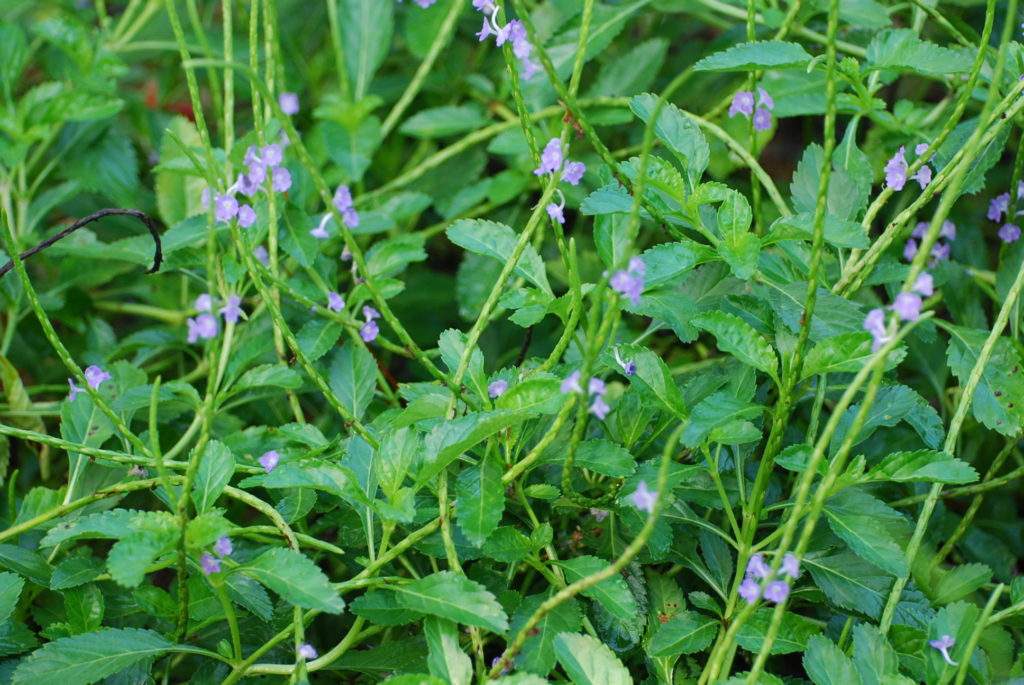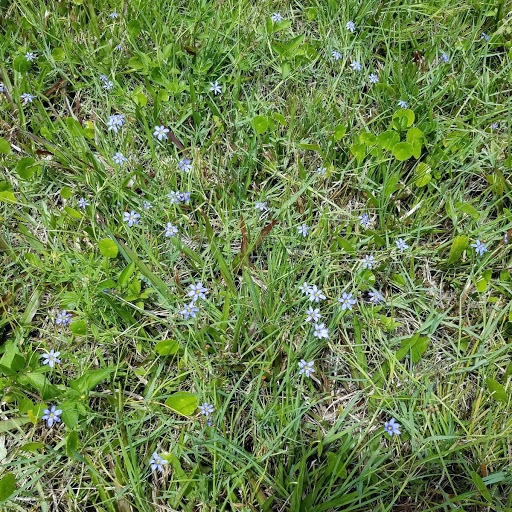Leavenworth’s Tickseed
Coreopsis leavenworthii
Leavenworth’s Tickseed is our Florida state wildflower and is abundant along moist, sunny roadsides in the spring and early summer. Some may be blooming in late summer if there is a lot of rain. It is not salt tolerant but will survive back of the dune when protected from salt air.
Just get a few started along the edge of your swale and spread the seeds by hand as they ripen for an even better turnout the next spring. The leaves are six inches long and the total height is usually two feet.
These delightful flowers will rise out of a wildflower planting and never come across as weedy volunteers the way Salvia can at times. The sparse, linear leaves give way to its neighbors.
You can start new ones from seed at any time in trays and plant them in your garden for an off season splash of color.
Mix with Prairie Iris, Yellow Canna, Duck Potato, Pineland Petunia, Water Hyssop, Black Eyed Susans, Twinflower, Browne’s Savory, Water Dropwort, Florida Lily and American Crinum Lily. Or just plant above the water line of a lake where the soil stays moist yet won’t flood and kill them.
Butterflies, bees, moths, beetles, and predatory wasps feed on the nectar. Seed eating birds visit them too.
For more information, click here.
Lance Leaf Coreopsis
Coreopsis lanceolata
Lance Leaf Coreopsis grows in the sandhills and swamp edges of North-Central and North Florida. This is one of our most drought tolerant native wildflowers that puts on a great show in the spring. It is not salt tolerant.
By June, the plant stops flowering, yet continues to grow and increase in size from the many germinating seedlings and offshoots.
The leaves are narrow and only six inches long. The yellow flowers are an inch across at the top of a ten inch stalk. These are plentiful and make an attractive display. A little fertilizer and water during the driest months will keep it healthy.
Mix with other short native Florida wildflowers for a unique edge. Try Sunshine Mimosa, Havana Scullcap, Spiderwort, Pineland Petunia, Pineland Pennyroyal, Love Grass, Silkgrass, Cat Tongue, Beach Verbena, Blazing Star, Twinflower and Silphium.
Bees, butterflies, moths and beetles visit the flowers and rabbits eat the leaves. Also, predatory wasps that eat beetle larva feed on the nectar. Don’t forget our insect predators when planting a garden.
Seed bearing wildflowers, grasses, trees, shrubs and weeds will keep seed eating birds like native sparrows, gold finches and painted buntings happy. Coreopsis is a good source of seed for these birds. See this site for more info, click here.
For a good description of Lance Leaf Coreopsis, click here.
Coral Honeysuckle
Lonicera sempervirens
Coral Honeysuckle is native to much of the East Coast including Central and North Florida and can be planted in South Florida. It naturally grows along the edge of forests, and on hedgerows and fences.
Rich, moist to dry soils with abundant organic matter and sunlight are needed to produce a healthy plant full of red tubular flowers.
The leaves are green above and a light bluish green below. If pruning is needed, cut back to a leafy stem. Do not cut to bare stems.
I have found that keeping the soil moist with occasional watering during drought is best for this plant. If planted in dry soil and neglected in South Florida, it will die out over a few months.
This is a great plant to grow on a fence, trellis, or woven into palm boots or tree branches. It makes a decent groundcover that rambles over boulders, down terrace walls, logs and other objects.
The bright red bitter berries are attractive to songbirds. The flowers have enough nectar that they can be plucked and the end sucked on for a drop of nectar. Don’t eat the flowers though.
Butterflies, hummingbirds and bumble bees visit the flowers. See this article for more info on bees, click here.
I would not eat any part of this plant. Although it is not deadly poisonous, it will make you sick. For more info on this click here.
Here is a good site for more info, click here.
Coastal Foxtail
Setaria corrugata
Coastal Foxtail is also called Coastal Bristlegrass. It occurs in pinelands, sandhills, coastal hammocks, protected areas of beaches, and the edge of salt marshes. The picture above is from Long Key growing under Buttonwood trees. I have found it along the Port Mayaka trail on the east side of Lake Okeechobee.
The three to four foot long stems come from a round clump and don’t wander, although they lay down and may take up a bit of space. The plant rarely gets over three feet tall. Just cut the stems back to the ground in December to rejuvenate the plant.
The seeds ripen in the fall, just when the painted buntings arrive for the winter. Each leaf may be 18 inches long and the seed spike ten inches long by an inch or less wide.
I have planted this under a pine tree, were pine roots make a deep hole impossible, and it is still going strong after six years. Seedlings come up abundantly and fill in any empty spaces.
There are a number of skipper butterflies, like the clouded skipper, that lay their eggs on grasses and will use this plant.
This is one of my favorite shade tolerant grasses and makes a nice replacement for the overused, even though it’s native, Fakahatchee Grass. Its lower height, clumping form and dark green leaves create an interesting mass. The fact that seed eating birds are attracted to it is why I feel that more should be planted.
A mix with shade tolerant ferns like Boston Fern, Goldenfoot fern and Swamp Fern would look nice. Try planting under a Slash Pine, Live or Laurel Oak, Red Maple, Hackberry, Florida Elm, Buttonwood and other trees.
I accidentally killed some by burning the old growth rather than cutting it back. Fortunately the seedlings came up and the planting is refreshed.
A Guide to Florida Grasses by Walter Kingsley Taylor has great pictures and descriptions. Sorry, but not much on the Net.
Climbing Aster
Symphyotrychum carolinianum
Carolina Aster is not one of my favorite plants because it only blooms in the fall and looks like a rangy weed the rest of the year. But, the masses of one inch, daisy like lavender flowers make this plant spectacular during its blooming season.
It is found along river banks, like the Loxahatchee River, and the edges of wetlands throughout all of Florida and the Southeast. Moist to wet soils are best. Short term flooding is OK but salt air and water along with prolonged drought are not tolerated.
The ten foot long stems will sprawl over objects and can be interwoven with Sabal Palm boots. I have planted masses along the edge of local lakes and had it do well for years.
Try mixing in with Cypress, Red Maple, Sweetbay Magnolia and other wetland trees and shrubs. Use it as a background to other more colorful flowers like Yellow Canna, Pickerelweed and Duck Potato. The blooms will attract butterflies and bees.
I first noticed this plant while canoeing down the Loxahatchee River near Jupiter, Florida in the fall. The masses of flowers draping over the riverbank and pouring into the water were magical. Native Crinum Lilies often massed in front of it with their fragrant white flowers going beautifully with the blue flowers of the aster.
Although you may not want to plant this in front of your doorway, it can provide a really delightful display of color in the fall when other plants are winding down their flowering season.
For more information click here.
Browne’s Savory
Micromeria brownei
Browne’s Savory is now Clinopodium brownei. This is a creeping mint that grows to three inches tall in wet soil and gives off a delightful pepperminty fragrance when walked on. In the aquarium trade it is called Creeping Charlie. Just tie a small weight to the base of several cuttings and let them sink to the bottom of the tank.
Plant in wet soil to cover the area; some weeding may be needed. It is found throughout Florida and the Southeast and makes a great tea either raw or dried and steeped. Adjust the dose to your liking. There is mention that pregnant women should avoid this.
The light green round leaves are half an inch across and the lavender flowers are of similar size. Although sparse, they make a nice effect when in mass.
Plants with similar growth in wet soil include: Water Hyssop, Fog Fruit, Swamp Twinflower (Click for more info) and Sunshine Mimosa.
Taller plants to mix in include: Yellow Canna, Prairie Iris, Florida Lily, American Crinum Lily, Duck Potato, Tickseed, Swamp and Marsh Ferns and Salt Marsh Mallow.
If you have a wet ditch, just fill it with these plants and enjoy the beauty. I did this in my front swale and it has looked great for years with only occasional weeding.
The best thing to do is plant some were it will grow out onto a pathway for people to step on and release the minty fragrance.
A depression lined with rubber and fed from the AC drain makes an easy bog planting. Water may be required only during the winter months when the AC is off.
Salt water and drought are not tolerated, but flooding for days will not bother it at all. So don’t fill the wet areas of your yard with sand, withstand the urge and plant Browne’s savory instead.
Lots of great images, click here.
Bracken Fern
Pteridium aquilinum var. caudatum
Bracken Fern is a fast spreading fern averaging three feet tall, yet to 20 feet when climbing up nearby trees and shrubs. It grows in dry pinelands, back dunes and hammocks spreading by underground rhizomes many feet from where planted.
After a fire in natural areas containing this plant, it is one of the first to send up new growth. This is one of the best plants for large areas in need of a groundcover. If you have pinelands, a canal bank, roadside swale, or any other large, dry area of the yard in need of a permanent cover, this will do the job.
Planted six to 10 feet apart, bracken fern will grow together within the year. Break things up with Saw Palmetto, Beauty Berry, Myrsine, Wild Coffee, Marlberry and other dense shrubs that can compete for space.
If the fronds become too old and ugly, just mow; new fiddleheads will appear in a few days. This is excellent cover for wildlife but not an abundant source of food for them. But for humans, Bracken Fern is said to be edible if the very young fiddle heads are boiled in plenty of water first. Click for more info, and here. Do not plant where horses or livestock can eat it as the older leaves are poisonous to them.
Here are some great images, click here.
Boston Fern
Nephrolepis exaltata
Boston Fern is native to all of Florida and grows in moist shady woodlands and swamps away from the ocean. Although it spreads from underground roots, I have never seen it take over an area the way the invasive ferns do.
The leaves are usually below three feet long and less than six inches wide. I use this plant in moist sites and sites too dry for the Marsh and Swamp ferns such as under an oak tree.
The problem with this great plant is that there are two invasive ferns and a native one that look very similar. It is maddening to figure out the differences because the characteristics often overlap.
For information about the Asian Sword Fern, click here, and here.
For information about the Tuberous Sword Fern click here.
Let’s throw in the native Giant Sword fern to really get you confused. Click for more info, and here.
I look for the auricle or pointed foot at the base of each leaflet that points toward the top of the leaf. If the foot is wedge shaped and doesn’t touch the midvein of the leaf above it, then it is native Boston Fern. If the foot is wedge shaped and touches the midvein above it, then it’s Tuberous Sword Fern.
Look at the lower leaflets because the upper ones tend to bunch together for both ferns. The tuberous Sword Fern has small tubers on the roots. Just dig it up to see.
The Asian Sword Fern has a pointed foot on the leaflet. The leaf is a bit larger than the Boston Fern yet smaller than the Native Giant Sword Fern.
The lance shaped scales at the base of the Asian Sword Fern’s new leaves are dark brown with a lighter brown edge. You will need a 10X hand lens to see this. Both native ferns have a dark brown spot on scattered light brown fluffy scales.
For large shady areas that won’t have foot traffic, Boston Fern is a great long term choice. It can be mixed with Giant Sword fern but will crowd other less territorial plants.
You can also encourage it to climb up a Cabbage Palm or other support. Just cut it to the ground if it looks old and new growth will soon fill in.
Click for more info.
And my article on all four sword ferns, The Sword Ferns
Blue Porterweed
Stachytarpheta jamaicensis
Blue Porterweed is found in the Rocklands of the Everglades to Key West in open, sunny places. The leaves are three inches long and a bit leathery and smooth. It has a low, mat forming growth usually under 18 inches tall.
The small blue flowers are born on a whip like spike and are very attractive to butterflies. The larva of the Tropical Buckeye Butterfly feeds on the leaves.
The exotic Nettleleaf Vervain is up to six feet tall. Its leaves have a more quilted look and may be a bit hairy. It is invasive and is almost always sold as the native species. It should not be planted. Click here for more info.
Blue Porterweed prefers dry to moist soil and is surprisingly tolerant of short term fresh water flooding. It tolerates some salt air in back of other coastal shrubs.
This makes a nice edge along a butterfly garden where it will live for years unless there is a freeze. Usually it comes back from stubs or seedlings. You may want to keep it just a bit back from where its ranginess can be noted easily.
The stems are hollowed by a moth caterpillar during the winter. Because of this, the plant should be cut back to a few inches and the stems thrown away. In March, when the weather warms, new growth will fill out the planting and fresh flowers will form until late fall.
In the Florida Keys native Porterweed is found along the coast behind Sea Lavender, Chapman’s Cassia, Beach Elder, Sea Oxeye Daisy, Salt Meadow Cordgrass, Blackbead, Black Torch, Bay Cedar and Silver Palm.
You can mix this plant with your favorite wildflowers and enjoy the many butterflies that it attracts.
For more information click here.
Blue Eyed Grass
Sisyrinchium angustifolium
Blue Eyed Grass or Narrowleaf Blueeyed-Grass can be found from the Florida Keys through eastern Canada and west to Texas. It is in the Iris family and has half inch wide blue flowers with a yellow center.
Beware of the Annual Blue Eyed Grass which is native to South America and can spread throughout your yard. Click here for more info.
It needs fresh water, full sun and constantly moist soil to survive. Plants are in clumps that may be inches to a foot or more wide. They are usually below 12 inches tall.
When found in the wild it is often mixed with Tick Seed, Pineland Petunia, Pineland Pinklet, Largeflower Rosegentian (Marsh Pink), Silkgrass, Florida Lily and Creeping Charlie.
In the garden you can combine it with the above and Prairie Iris, Yellow Canna, American Crinum Lily, Browne’s Savory, Glade Lobelia, Marsh Fern, Little Blue Stem and other wetland species.
I have seen wet medians that were covered with Narrowleaf Blueeyed Grass in bloom. The dark blue flowers made an eye catching display. Too bad they only bloom in the spring and not all year long.
So instead of dumping fill to level the low wet areas of your yard, try planting with Blue Eyed Grass and other wetland species to create a wonderful wet prairie. Cypress, Pondapple, Buttonbush, Red Maple and Sweetbay Magnolia trees make a nice background on the north side.
For more info click here, and here.
